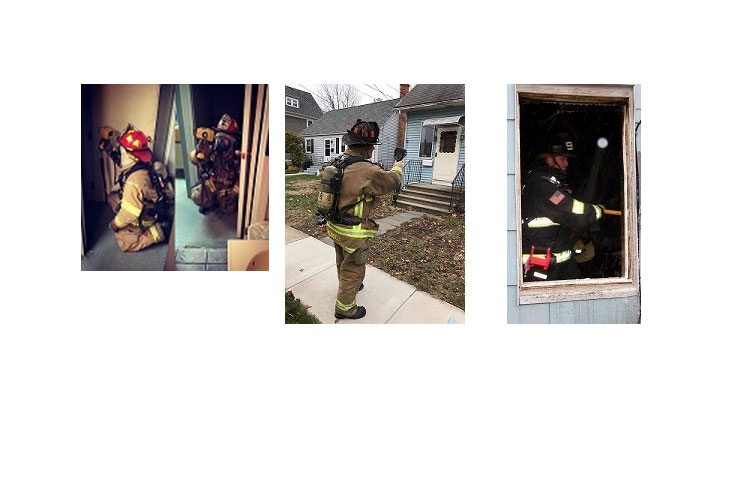
Interior Operations

Photo credit to PJ Lague. West Warwick Fire Department and Eric Munsell, West Hartford Fire Department
By AB Turenne
With many departments forced to operate at minimum staffing levels, an ongoing tactical debate centers on which tactic to implement first: victim rescue or fire suppression. Although these decisions must be made on a case-by-case basis and are dependent on a great number of variables, one thing is true: The use of a thermal imaging camera (TIC) will greatly aid you in accomplishing your fireground objectives efficiently and effectively.
TIC Use and Benefit: Search & Rescue
In some cases the choice is clear. Victims showing at windows or reliable information on victim location will take precedent over fire suppression. But let’s change it up and remove the obvious from the equation. Our priority is to search and remove all occupants from the structure in an effort to sweep every room/compartment as effectively and efficiently as possible. As a search team, you should be readily equipped with (at a minimum) a flashlight, radio, hand tool, and a TIC. When clearing a room, we all use the basics taught in our initial firefighting training–searching high, low, below, and behind fixed items such as beds and wardrobes and in closets, using the handle of an ax (some tools can cause more harm to occupants than the actual environment) to increase your reach when searching, searching along with a partner in opposing directions of travel (perform a right-handed search while your partner performs a left-handed search) and meeting in the middle, and more.
Implementing the TIC in this situation by positioning yourself in the doorway and performing scans to sweep and clear the room quickly will allow firefighters to save energy and conserve air, thus allowing them to search a greater area more quickly.
RELATED
The Thermal Imaging Camera (TIC) and the Fire Service: Versatile Use of the TIC and its Benefits to Daily Operations
Thermal Imaging Size-Up
THERMAL IMAGING FOR THE FIRE SERVICE, PART 3: THERMAL CHARACTERISTICS
THERMAL IMAGING FOR THE FIRE SERVICE, PART 4: THERMAL IMAGING DEVICES
THERMAL IMAGING FOR THE FIRE SERVICE, PART 5: TACTICS FOR FIRE ATTACK
THERMAL IMAGING FOR THE FIRE SERVICE, PART 6: THE SEARCH
TIC Use and Benefit: Fire Suppression
Similarly, the TIC has proven to be tremendously beneficial while stretching in and suppressing the fire from inside the structure. A well-executed exterior 360 degree size-up of a structure generally makes it easier to locate and suppress the fire; however, when compartmented or isolated in an area without windows, the TIC will prove to be of value while performing interior operations. Not only will it help to identify the location of the fire, it will also show you where the fire is moving as well—this is something we must be aware of for both victim survival and firefighter safety.
With the TIC in hand and the hoseline advancing through the structure, scan each room and compartment to gain a better understanding of conditions. The infrared technology at your fingertips provides the advantage of seeing through smoke (remember that glass and shiny objects could potentially give false readings such as reflections) and the ability to detect rapid increases in temperature. As water is applied, this same technique will confirm temperature drop as well. Be cautious when sweeping to scan slowly to allow for the camera to react and provide accurate readings. The company officer can direct and guide along with the camera to his or her hose team by leading from room to room and scanning, rather than following up behind them.
TIC Use and Benefit: Overhaul
A systematic approach to performing overhaul with a TIC can help identify, locate, and extinguish any hidden pockets of fire and keep you from being dispatched later for an embarrassing rekindle. Capitalize on the TIC by looking in knee walls and other concealed spaces. Scan the walls in the surrounding areas, comparing temperature differences, to better identify whether or not your findings warrant “opening up.”
Without a doubt, the implementation of a TIC into your interior operations is a great asset in making up for the loss sense of sight. However, never rely solely on the TIC. Use your experience and the senses available to you when executing performing searches, suppression, and overhaul.
In part 3 of this series, I will take a look at TIC use on the Hazardous Materials Incident Scene.
 AB Turenne is an 18-year veteran of the fire service in Eastern Connecticut and is currently employed as a Firefighter/EMT-B with the Electric Boat Fire Department in the Submarine Capital of the World in Groton, Connecticut. He is a Certified Level II Fire Service Instructor and recent graduate from the Masters of Public Administration program at Anna Maria College, and is a frequent contributor the Fire Engineering Training Community.
AB Turenne is an 18-year veteran of the fire service in Eastern Connecticut and is currently employed as a Firefighter/EMT-B with the Electric Boat Fire Department in the Submarine Capital of the World in Groton, Connecticut. He is a Certified Level II Fire Service Instructor and recent graduate from the Masters of Public Administration program at Anna Maria College, and is a frequent contributor the Fire Engineering Training Community.

